The iPhone 6 Plus Mini-Review: Apple's First Phablet
by Joshua Ho on September 30, 2014 8:00 AM EST- Posted in
- Smartphones
- Apple
- Mobile
- iOS
- iPhone 6 Plus
Display
While the iPhone 6 Plus’ display is largely similar to the iPhone 6’s display, there are still a few areas worth talking about. The first area is resolution, which is noticeably better on the iPhone 6 Plus on close examination. In general, there’s less aliasing that is visible on the display. While text rendering in general is even better, the improved resolution is most obvious in the rotation lock symbol, which is noticeably smoother and rounder. The use of the 2208x1242 resolution with downscaling should also have a similar effect to FSAA (Full Screen Anti-Aliasing), which will reduce the effects of aliasing on the display.
Outside of simple resolution testing, we also need to test all other aspects of the display. In order to do this, we turn to SpectraCal’s CalMAN 5 with a custom workflow. As always, we use a spectrophotometer to measure color to ensure accurate results. For this review, I won’t go over viewing angles as that’s covered in the iPhone 6 review.
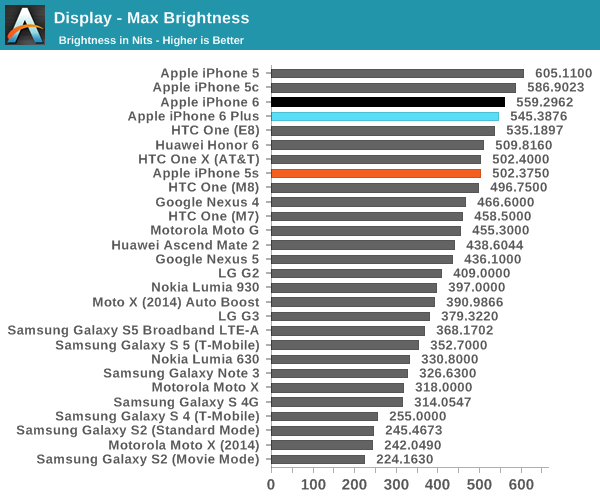
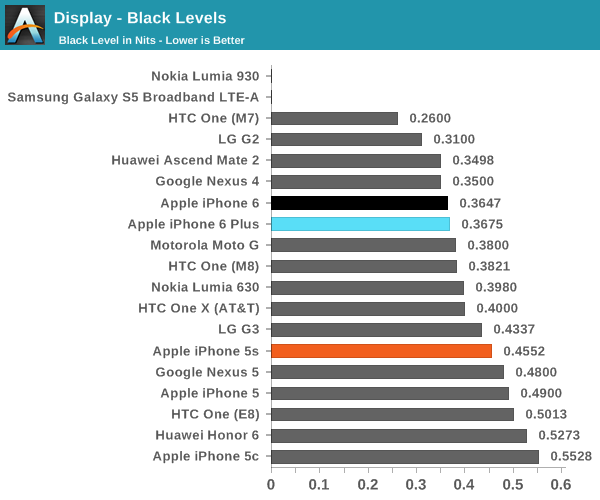
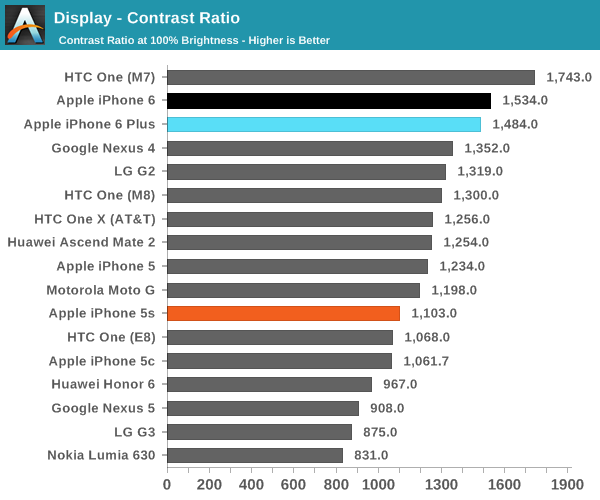
Our first test is of peak luminance and contrast. At maximum, the contrast difference between the iPhone 6 and 6 Plus is relatively small, and the difference in peak luminance is relatively small as well. I suspect that this means that Apple isn’t quite at the point where backlight luminous efficiency is rapidly falling off the way it seems to at 500+ PPI RGB LCD displays.

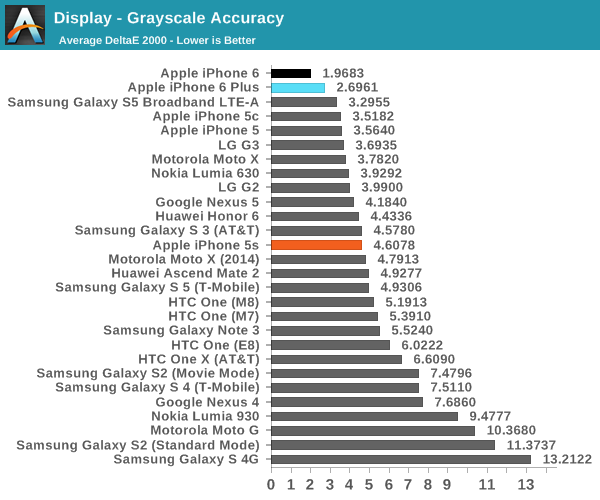
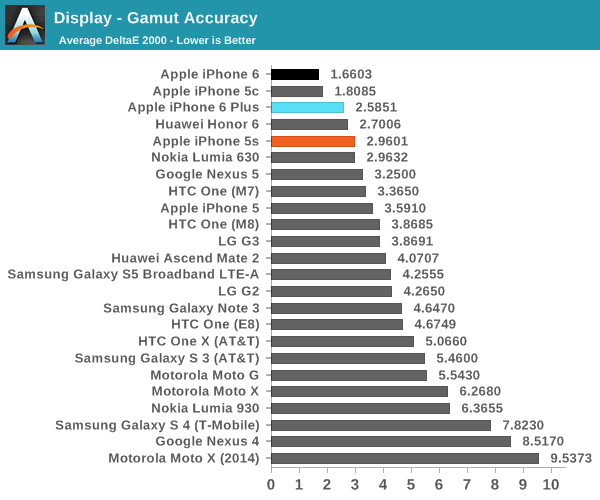
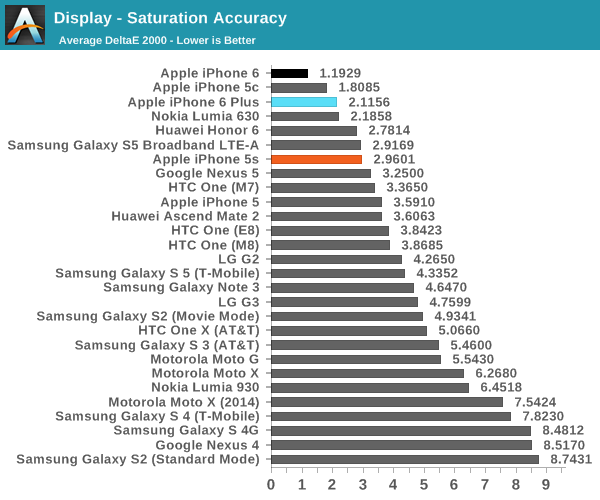
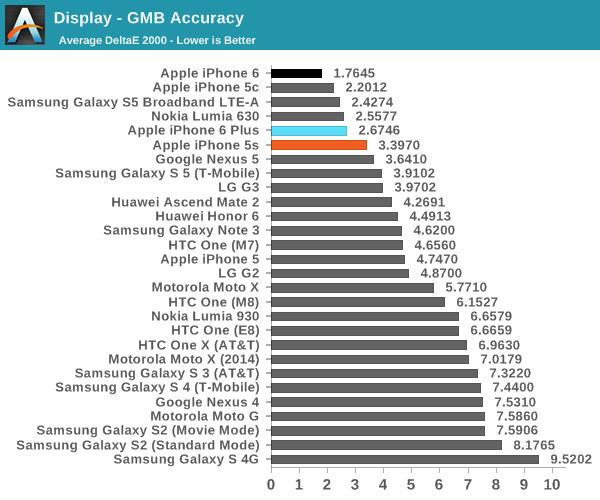
While I normally walk through each type of calibration test, there’s relatively little need in this case as the iPhone 6 Plus is close to the iPhone 6. There are some differences and the iPhone 6 is nearly perfect while the 6 Plus ends up being better than the 5s but not quite at the same level as the 6. I suspect this could be due to production variance, but these are different panels so without additional test units we can't say for certain. The iPhone 6 Plus display is quite close to the iPhone 6’s display in most regards, only larger; this is effectively as good as it gets for an LCD display.
Camera
Ultimately the change to the camera is the one difference that really sets the iPhone 6 and 6 Plus apart outside of the change in size. This one difference is optical image stabilization, or OIS. However, at first it's almost impossible to tell whether OIS is active. As someone who has used multiple cameras with OIS, this is a very odd sensation. Normally, OIS means that it's possible to see the effect of reverse accommodation in either the camera preview or while recording video, but I never saw these effects while recording video, whether in daytime or at night. In fact, I'm not even sure that video is ever optically stabilized, as seen in the videos below. I'm not sure why Apple chose to do this, as video recording is already cropped and would hide most of the odd effects that occur at the edges of the field of view when using OIS.
Putting aside OIS in video, it's obvious that the one area where OIS would be put to use is low light photography. Examining the EXIF data of low light photos, I was rather surprised to discover that in single shot mode (burst mode caps shutter speed to 1/15s) that the iPhone 6 Plus never exceeds 500 ISO. However, in order to keep pace with the iPhone 6's maximum of 2000 ISO and 1/15s exposure time, the iPhone 6 Plus drives exposure time as far as a quarter of a second, which is four times as long.
I really can't emphasize how incredible it is that Apple has pulled this off as it felt like something was wrong when I was testing low light photos as seen below. Normally, such a long exposure time entails noticeable trade-offs, but as far as I can tell motion blur is close to what I see on the iPhone 6 in low light. This seems to be the product of the multiple exposure combination that was mentioned in the keynote, and it really does work as advertised. While some benefit can be seen in the lightbox shot above, it's really in low light conditions like the photo below where we see significant benefits.
As you might expect, there's not much difference in daytime photos. I'm guessing that OIS is disabled above a certain shutter speed in order to reduce the distortion and blurriness that can come from OIS.


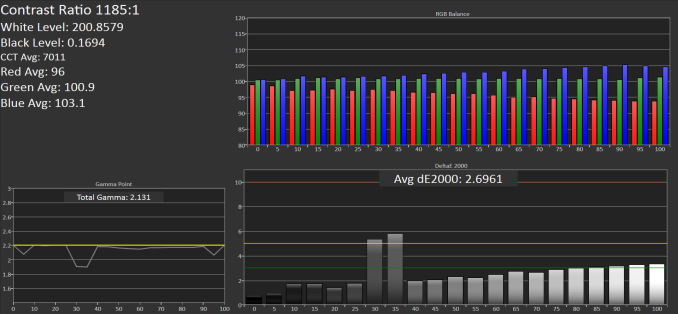
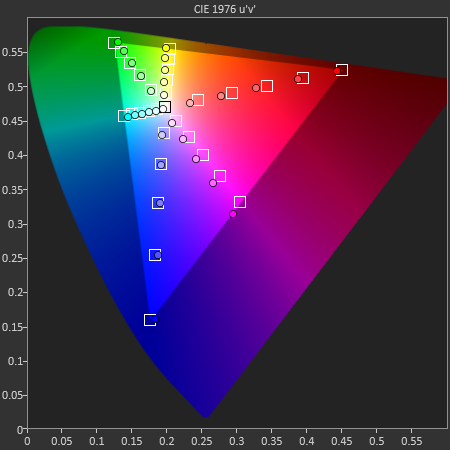
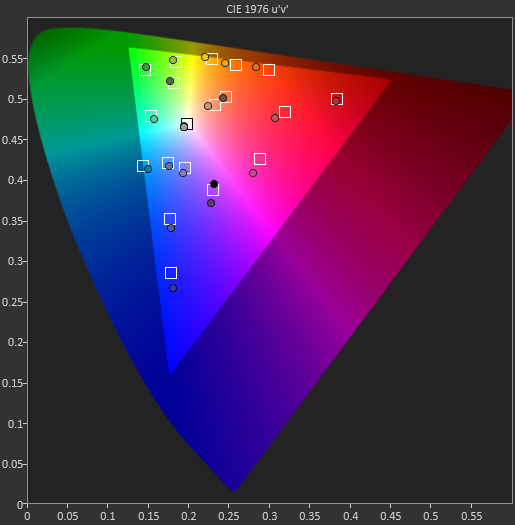






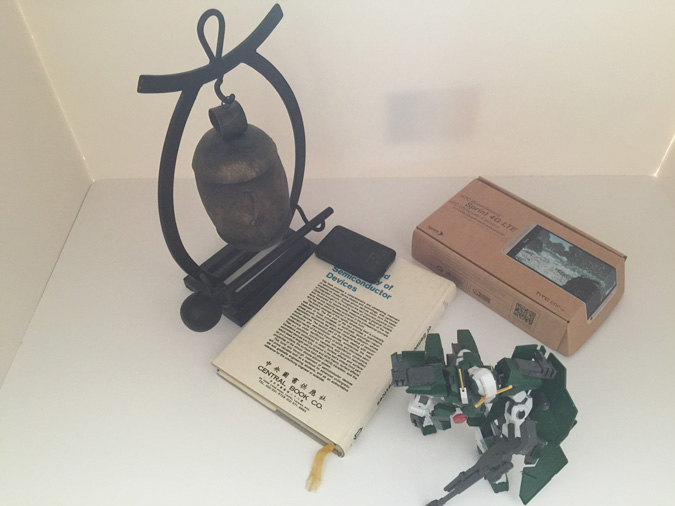






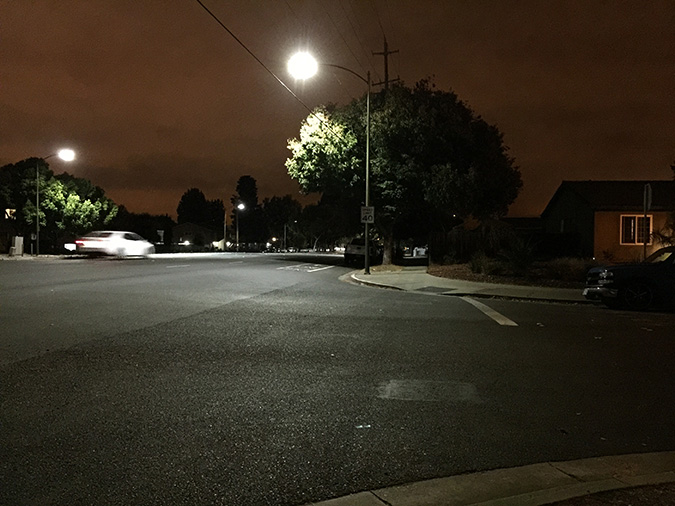















191 Comments
View All Comments
MacrosTheBlack - Tuesday, September 30, 2014 - link
Yet apple's A series "dual core" processors typically outperform the latest quad core flavor of the week and do it at a lower clock rate. Derp. Go back to your cave now.Alexey291 - Tuesday, September 30, 2014 - link
yeeeeeeeah usually in a single over-optimised benchmark aka sunspider :DAaaaaand nothing much else.
bigstrudel - Wednesday, October 1, 2014 - link
And Octane, Browsermark, Kraken, Peacekeeper, WebXPRT...and Sunspider. And that's just the web benchmarks.nerd1 - Wednesday, October 1, 2014 - link
Browser performance is single threaded testing and obviously favors higher-clocked low-core APs (or apple devices). Also don't forget that anandtech is always using chrome browser for testing android browser performace, which is almost twice slower than samsung's stock browsers - and they are using highly optimized Safari for testing apples. Totally not fair.akdj - Thursday, October 2, 2014 - link
Samsung's 'stock' browser? FAST? You've GOT to be kidding me. I've got the Note 3 and at least a dozen browsers. Samsung's is by FAR & AWAY the slowest turtle of them all. Why continue spewing? Did you not read any of the article? The review on the '6'? This A8 is top of the heap. Browsers. Computationally. Graphically. While not always number one, it's in the top two or three in every bench performed including GB3/Kraken/Octane. Not to mention the display accuracy, battery efficiency and ...well, yeah. Totally. Fair.beaker7 - Tuesday, September 30, 2014 - link
Feel better?melgross - Tuesday, September 30, 2014 - link
Wasting our time again, I see.bitNine - Tuesday, September 30, 2014 - link
Have you ever watched someone do a really terrible job at something, then turned around and learned from those mistakes and built something better? That's what Apple is doing. It's actually quite genius. They watch Samsung, HTC and LG fail in certain areas as they pump out the next pointless device which a few thousand people will buy, just to struggle to compete. Meanwhile, using an OS which is fragmented to its core, and reminiscent of Windows Mobile <=6.5. Google makes it, HTC modifies it and ruins it (just like they always did with windows mobile), and unfortunately community roms aren't much better because they lack QA. Buggy, susceptible to malware, but wide open and capable of doing more.As for copying and saying Apple has no innovation, what's with Samsung suddenly copying the fingerprint reader in the home button? What about the fact that Apple is first to have 64bit architecture? All the rest are eons behind, and STILL haven't released any devices with 64bit. It's no longer 2005. They all copy each other in order to compete, and that's what makes ALL DEVICES better. The sooner you get that through your head, and past those ugly blinders you're wearing, the better.
When you directly compare Samsung flagship phones to Apple phones, they constantly one-up each other. You'd know that if you actually paid attention to the raw tests done here at Anandtech. The S5 beat the iPhone 5S and the iPhone 6 destroys the S5 (except in physics category). It's a leap-frog game, and one you clearly can't see because of those aforementioned blinders.
Over-expensive? All other device types aside, when you compare prices with Samsung, LG and HTC, Apple is quite competitive. Not quite so in the tablet market, but phones are competitive. They are all $199 with a contract, and most of them start in the $650 range for full price.
Why is it you believe everyone needs more than 16GB. There are plenty of people out there who wouldn't care about more space. Apple caters to those people and provides a $100 cheaper phone for that reason. They know the market, and you obviously don't.
As for pixel density, who gives a crap which has a higher pixel density considering that 100% of people can't see the individual pixels anyway. I've got 20/15 vision and have never had a complaint about any retina screen being too low resolution. That's just a specs game that iHaters are quick to exploit, and it's something that makes it clear that you don't actually know what you're talking about when it really comes down to it. The only thing you actually got right about the screen is the superiority of OLED over standard LCD (even IPS). Any idea what a larger, and unnecessary, resolution does for the phone? It uses more power, which equals less battery life. Especially when you're talking about a backlit screen. There is simply no need to have a higher resolution screen when it's unnecessary. Pushing for a higher resolution and convincing consumers that it's so necessary, is just as stupid as attaching a marketing term like retina display. They are the same thing, but your brlinders don't allow you to see it. I mean, "Super AMOLED" is a Samsung marketing term. There's not even a reason to have the AM because OLED is, by default, Active Matrix. Yet for some reason, you don't realize this because of your blinders. Don't forget that OLED screens tent to deteriorate faster than an LCD, meaning that iPhone displays will outlast Samsung's. And nevermind that Samsung makes over 90% of OLED phone displays in existence today, and they can barely keep up with their own demand for screens. Adding another several million displays doesn't help that matter. The supply and manufacturing chain must be developed first.
Now, let's take a look at the differences between Samsung's flashy new phone, the Galaxy Note 4. OMG, a fingerprint reader! That's it, aside from a processor upgrade. There's nothing else to the phone aside from the basic updates. It's like the update from the iPhone 5 to the 5S. But you'd never in a million years admit that it's EXACTLY THE SAME THING APPLE DOES, because of, again, the blinders.
I am not dissing Android or Android phones, because Android is an awesome OS with its own faults just like iOS and WP. They are all the same. There is nothing special about what Samsung, HTC and LG do. Just like there's really nothing special about what Apple does. Unfortunately, you're so one-sided that your blinders don't allow you to see that they are all the same, and that the competion between them is exactly what we need and want. Apple gives you better Android phones, and Android phones give iPhone users better iPhones. They are all innovative, and they all have awesome ideas that are better than the other side of the fence.
As I always say, anyone who says one platform is clearly better than the other (other than saying it's better specifically, and only, for themselves), doesn't know wtf they're talking about. You're one of "those people".
nerd1 - Wednesday, October 1, 2014 - link
What a load of BS. Apple is milking customers by not providing memory expansion option (64GB microSD now costs as little as $30, and it will be even cheaper!), and NEVER ever lowers the prices of their device for a whole year. All other OEMs offer cheaper devices from the start, even cheaper with memory expansion, and that gets even more cheaper as time goes by.And apple has the worst hardware - iPhone 6 has worse display than $300 phones, and 1GB of ram is just downright laughable in 2014. Oh there IS passive matrix OLED by the way.
Compare two keynotes from samsung and apple. Sammy showed WQHD OLED, new pen with 2048 levels of sensitivity and tilt sensing, new larger and higher resolution front and back cameras, curved screen, and finally portable VR device presented by god damn John Carmack himself.
Was that ANYTHING new with the apple keynote? Absolutely nothing. And their iPhone 6 plus offers basically nothing new over standard phone (sammy has active pen and multi-screen multitasking for example)
akdj - Thursday, October 2, 2014 - link
You'd do yourself a favor reading bitNine's response to you. Or learning before speaking. Apple released a new CODE! (Swift), a low level code and OpenGL ES overhead elimator (Metal), integrated iOS and OS X with Handoff and Continuity and contrary to your ridiculous OLED fantasies and ignorance about iphone 6's display (or the actual review itself, did you read it?), it's the Best in the Business Bud!I love my Note. Love my iPhone. Dig my iPad and enjoy my HP 2in1. Don't be a DBag and preach from one side of the fence. Jump it and open your mind.
You sound ridiculous (or 13).